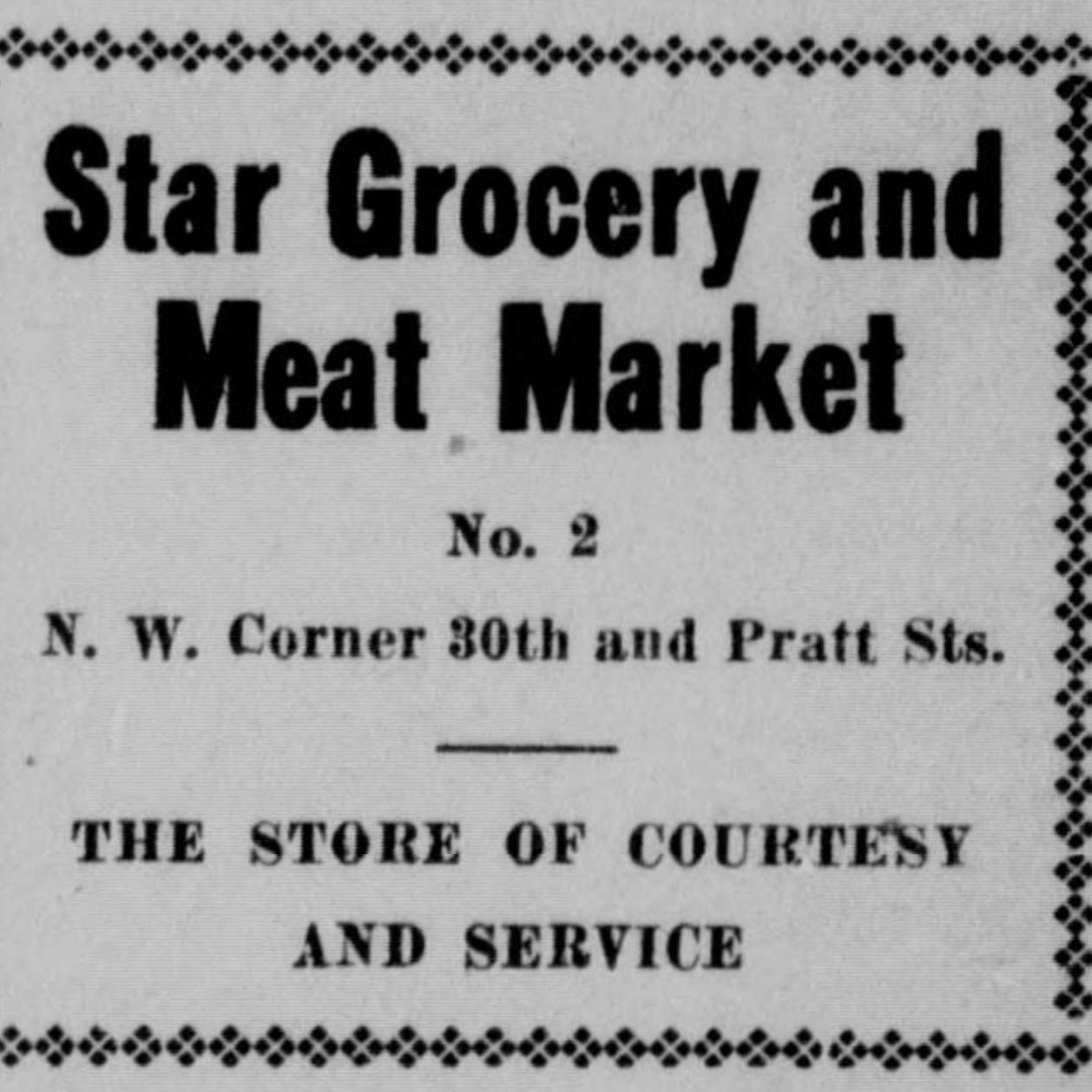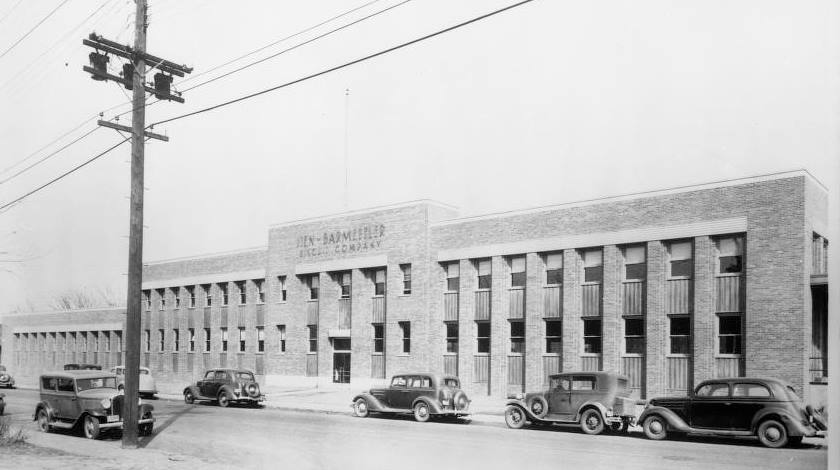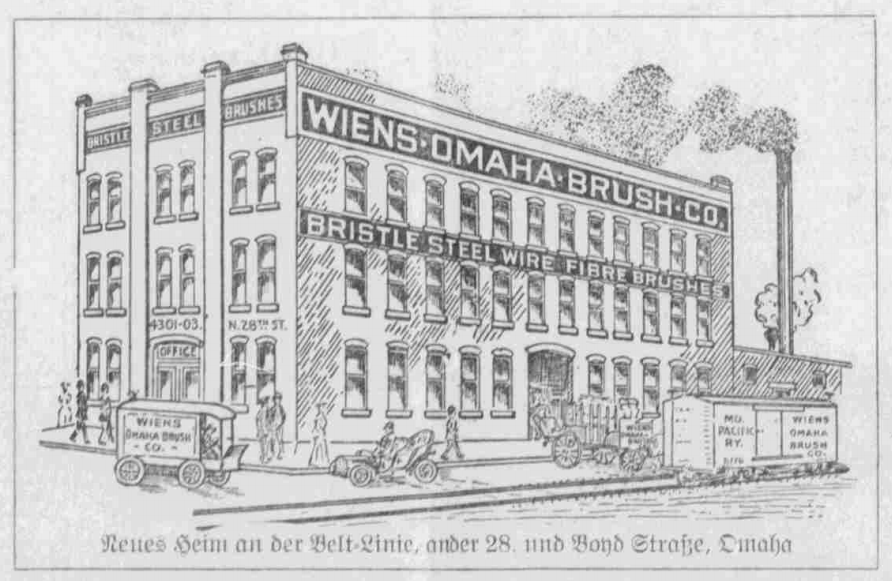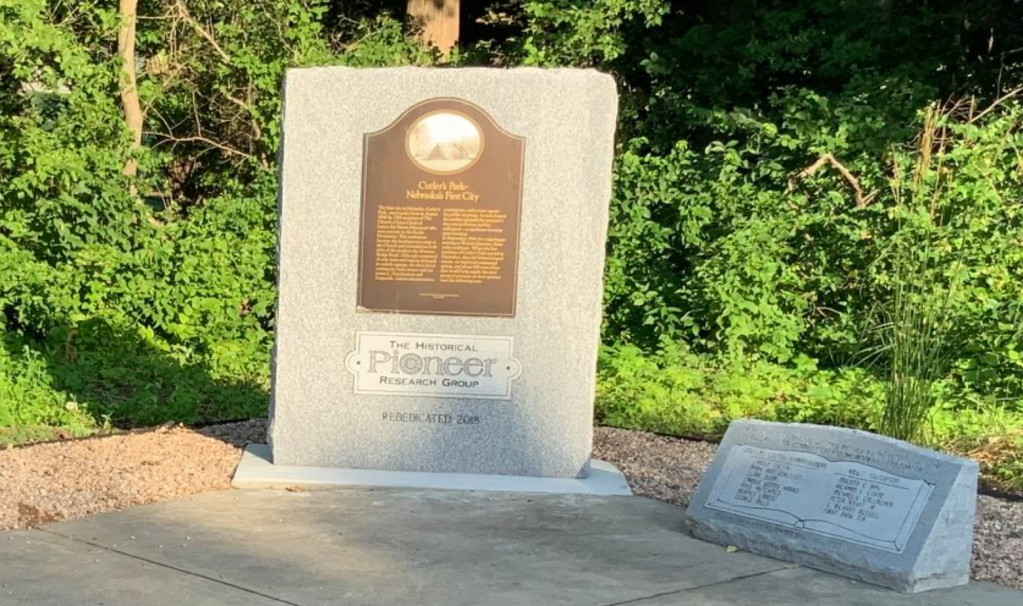
Many North Omaha neighborhoods along North 30th Street were started as idyllic suburban developments for middle class white people. With mixes of houses, light industries, parks, churches, and businesses, many were segregated for the first several decades of their existences. However, in one neighborhood a developer intentionally broke Omaha’s color line and offered new family housing for African American veterans. This is a history of the Bedford Place neighborhood.
Location

Located just south of the 30th and Ames Commercial Historic District, the Bedford Place neighborhood history was owned by Augustus and Herman Kountze in the 1870s. The Kountze Brothers were bankers and real estate speculators in Omaha, and they picked up the land cheap with the intent of selling it for a tidy profit.
The neighborhood was formally started in 1885 with the Belt Line Railroad. Real estate developers saw the potential of a suburban working-class and middle class oasis far away from the hustle and bustle of the industries and businesses in downtown Omaha. Bordering several other suburban developments like Collier Place, Monmouth Park, and Saratoga, the neighborhood was named after the Bedford Avenue, which spans the south edge of the neighborhood. That street was named after Jefferson W. Bedford (1845-1917), an early Omaha politician.
Today, the boundaries of the Bedford Place neighborhood span from Spaulding Street on the north to Bedford Avenue on the south; and from the North Freeway on the east to John A. Creighton Boulevard on the west. Other nearby landmarks include Adams Park and the Spencer Street Projects.

There have been many forms of transportation in the Bedford Place neighborhood over the years. North 30th Street has always been the major thoroughfare for residents. Originally traveled by foot, by horse, or by horse-pulled wagons, 30th was first paved with gravel and later with brick. Its surface has been asphalt in Bedford Place since the 1920s.
Starting in the early 1890s, the section of North 30th just south of Ames Avenue was served by horse-drawn streetcars. In 1900, there was a competition between the horse-drawn railway company and the new electric streetcar company, the latter of which won out. That company was called the Omaha and Council Bluffs Street Railway Company, and ran along North 30th Street through Bedford Place from 1900 through the early 1950s. Streetcar service ended permanently in the city in 1956.
Buses have traveled through the neighborhood since the 1950s. The North Freeway was installed nearby in the 1970s, without any exits to the neighborhood. The Belt Line Railway originally carried passengers to the nearby Druid Hill Depot from the 1880s through the 1890s, when it started to carry industrial cargo exclusively. That ran through the 1970s, and was removed entirely in the 1990s. There has been recent talk about turning the old rail bed into an exercise trail for North Omaha.

In 1972, the City of Omaha built a pedestrian overpass from the east side of North 30th Street to the west side at Spaulding Street. Ostensibly designed to carry students to Druid Hill School, today the bridge sits largely unused.
Landmarks

After launching its development in 1886, the Bedford Place neighborhood grew slowly. Lots were originally sold for $250 to $600, and viewers were offered a lot of incentives to come look by downtown real estate agents anxious to sell to them.
One of the earliest landmarks in Bedford Place was a horse racing track on the southwest corner of North 30th and Spaulding Streets from the 1870s through 1900. Located across the street from Druid Hill School, it was a public baseball field from 1900 through the 1940s. Amateur leagues played there for decades.

More than one hundred houses were built by 1920 though, along with numerous businesses and a few churches. However, much of North Omaha between Lake Street and Florence was dingy during this era, with dirt streets, no sewers, few sidewalks, and an overall absence of public investment by the City of Omaha.

The neighborhood was graced with a public school from 1885 onward. Named for the nearby Druid Hill, the school has gone through many changes over the years. Built in 1917, a second Druid Hill School building was designed for 500 students. In 1935 the school added the ninth grade for several years. During the next 25 years, the school remained stable. In 2002, Omaha Public Schools built a new Druid Hill Elementary School located at 4020 North 30th Street. The original building lost its name and now serves non-neurotypical and neurotypically diverse students.
Another neighborhood fixture was the Bedford Place Presbyterian Church, a mission opened in 1887 at 3028 Evans Street. It was open until 1913, when the congregation was renamed and moved to North 27th and Pratt Street in the nearby Prairie View neighborhood.
Integrated Housing?

Built in fits and starts from the 1880s through the 1920s, there were large pockets of underdeveloped blocks in the Bedford Place neighborhood from the 1930s through World War II. Starting in 1946, the post-was housing boom in-filled every neighborhood along North 30th Street, including Bedford Place, and between 1945 and 1955, more than 50 new homes were constructed. Throughout that entire time period most Bedford Place homes were beyond reach to African American homebuyers, separated from them by redlining intended to maintain white supremacy.
However, around 1955 real estate agents became anxious to sell homes west of North 72nd Street and northwest of Fontenelle Boulevard and Ames Avenue. To do this, they sold African Americans homes in Bedford Place, and then convinced white residents their new neighbors would destroy the value of their homes. This drove Bedford Place’s longtime residents out with fear-mongering through a technique called block-busting. With the advent of the Civil Rights Act of 1964 and the Fair Housing Act of 1968, white flight went into high gear and the neighborhood was almost entirely Black residents by 1970.

In 1965, Omaha Public Schools added a giant mid-century modern style addition onto the Druid Hill School building with the intention of having it serve as a junior high school. However, when white flight sent white students away from the area that junior high plan was never implemented. Druid Hill became predominantly African American by 1970, and has been largely segregated with few white students since then.

Despite promoting the dream of integration in the 1950s and 1960s, this neighborhood was victim to white flight and white supremacy. Integrated housing in Bedford Place lasted for less than a decade after 1955, and for the last 40 years, the neighborhood has been almost entirely African American residents. It shows little likelihood of changing.
Businesses



Located along the North 30th Street corridor, the Bedford Place neighborhood has been home to hundreds of businesses throughout the last 140 years. They’ve included dozens of stores and restaurants, as well as bars and taverns, gas stations, grocers, drug stores and more.
After being a Phillips 66 gas station from 1915 through the 1940s, there was a car dealer at North 30th and Bedford for 20 years. There was a Seventh Day Adventist Church at this same intersection for several decades. The MAD DADS Information Center was there in the 1990s.

There was a barber shop on the northeast corner of 30th and Pinkney between 1900 and 1909. The next year, a two-story grocery building was constructed on the corner at 3501 North 30th Street, and a grocery store owned by Michael Leaf was opened there. Stark Drug store opened there right after World War II, and Kelly Drug took over the space in 1950. A neighborhood mainstay, Kelly Drug was sold to James Arion Washington in 1971, and its named was changed to Kelly Sundries. That business stayed open into the 1990s. Today, the building still stands and is home to a liquor store.

In 1932, the neighborhood was home to Gershun’s Store.
Between 1949 and 1997, there was a Diary Queen restaurant located at 3510 North 30th Street. The next year, the building was called Mary Queen, and in 2014 it was sold by a bank to a private owner. It was a drive-through liquor store for several years, but is closed today.

The intersection of North 30th and Sprague was home to two car dealerships at the height of the neighborhood’s complacency. In 1951, Gerelick Ford opened in the former Douglas Truck Company factory. They only stayed there for three years before opening a brand new building at North 30th and Fowler Avenue. In 1956, the same building became home to Dewey Chevrolet, which moved there from North 24th Street. In 1973, Dewey moved out of the neighborhood to west Omaha. The 40,000 square foot building was for sale “at a sacrifice price” of $9,500.

In 1960, there were 17 businesses along North 30th Street in Bedford Place. They included Kelly Pharmacy, Thrifty Food Mart, Martin’s Grocery, Blue Cross Animal Hospital, Robert’s Furniture and Ray’s Texaco.

One of the most iconic businesses in Bedford Place is also the oldest Black-owned restaurant in Omaha. Its called Time Out Foods and it is located at 3518 North 30th Street. Opened in 1969, it was first opened by the Swanson Corporation and promoted by Bob Gibson (1935-2020) and Bob Boozer (1937-2012), professional sports stars from North Omaha. In 1972, it became family-owned and operated, and it continues today in its original location.
In 2015, the neighborhood had just six businesses in the same stretch, including a car wash, a liquor store, a tobacco store, and the iconic Time Out fried chicken restaurant.
Stanley Budtkus had a grocery store on the northwest corner of North 30th and Pratt Street starting in 1890. In 1899, it was the voting place for the neighborhood.
From 1932 to 1963, the Kaplan Auto Company ran a repair shop at North 30th and Manderson. The building continues to be a repair shop today.

In 1964, an African American doctor named Dr. William H. Johnson built a new facility at 2912 Manderson Street in the Bedford Place neighborhood. Designed by the Leo Daly Company, the Johnson Medical Building is a Mid-Century Modern style office that was designed with concrete blocks and wooden crossbeams with a wooden ceiling. It originally had 22 rooms, a complete laboratory, x-ray, a pharmacy, and more, and won a design award from the Omaha Chamber of Commerce in 1965. In the 1990s, it became one of the Charles Drew Health Clinic outreach buildings, and continues in that role today. Serving primarily African American patients, the facility has been a bedrock in the North Omaha healthcare desert for it’s entire existence.
Industries






The Bedford Place neighborhoods grew between 1880 and 1900, and again from 1920 through 1930. After World War II there was infilling of houses until the mid-1950s. Central to this growth the entire time were many industrial factories nearby that drew in workers, managers, and their families. They included the Douglas Motors factory, the US Brush Company, the Murphy, Wasey and Company Factory, the US Mills plant, the Uncle Sam Cereal factory, the Woerner Wire Works, and the US Mills plant. There was also an iron foundry and other industries along the Belt Line Railway. More light industrial plants around 30th and Ames and in the neighboring Saratoga neighborhood brought many jobs within walking distance.

The Woerner Wire Works moved to the corner of North 30th and Evans in 1925. Established in 1892, it continues to operate at this corner today. It is by far the longest lasting business in the neighborhood.
The Douglas Motors Corporation opened a large new factory on the northeast corner of North 30th and Spaulding in 1918. Although just outside the neighborhood, many of the workers there lived in the neighborhood. The building was demolished in the 1960s.
Bedford Place Today

Because of its age, the changes in the Bedford Place neighborhood are innumerable. Instead of its beginnings as suburban sprawl away from the downtown core, today Bedford Place is an increasingly abandoned, overdeveloped, yet neglected urban environment engulfed by the pressures of white supremacy and poverty. The City of Omaha has neglected the streetscapes that once made this such an attractive place, including it’s paved streets, sidewalks, and greenery including trees and fields. Developers haven’t reinvested in the neighborhood in decades, and the decay of some of the homes is tragic.
In the larger community around North 30th and Ames including Bedford Place, between 1960 and 2010, the population dropped almost 2/3rd in those 50 years, from 4,500 in 1960 to 1,300 in 2013. According to the Omaha World-Herald, between 2010 and 2014, there were 57 gun crimes in Bedford Place alone.
However, longtime homeowners there say the neighborhood is remarkably quieter today. Gun violence and gang terrorism has dropped significantly.

Hope springs eternal and the prospects for the future are brightening. Since 1978, the Bedford Place Community Council has been a bulwark in the neighborhood working against decay and for unity. For more than 40 years, they’ve held annual neighborhood cleanups, sponsored picnics and special events, and held an annual banquet at the Elks Club to celebrate the people in the neighborhood.
Today the Bedford Place neighborhood continues soldiering on, hoping and working for the change it so desperately needs. There are no historic markers, no historic designations, or other histories written about the homes, streets, businesses, and institutions that made this neighborhood live for more than 140 years now.
However, this is a start. If you know of any details, have any questions, or otherwise want to ask anything leave a comment.
Historic Places

The Bedford Place neighborhood isn’t known for its historic places. However, there are still many structures in the neighborhood that are more than a century old. Following are some of them.
- Duplex (1923), 3813 North 28th Avenue
- House (1900), 3918 North 28th Avenue
- House (1890), 4010 North 28th Avenue
- House (1880), 4013 North 28th Avenue
- House (1895), 3534 North 28th Street
- House (1910), 3923 North 29th Street
- House (1885), 4003 North 29th Street
- House (1900), 4010 North 29th Street
- House (1911), 3724 North 30th Street
- Commercial building (1929), 3824 North 30th Street
- Commercial building (1905), 3825 North 30th Street
- House (1900) 2860 Ruggles Street
- House (1910), 2824 Ruggles Street
- House (1905), 2819 Ruggles Streeta
- House (1900), 2818 Ruggles Street
- House (1900), 2814 Ruggles Street
- House (1908), 2813 Ruggles Street
- House (1900), 2811 Ruggles Street
- House (1900), 2810 Ruggles Street
- Commercial building (1915), 2801 Sprague Street
- House (1885), 2802 Spaulding Street
- House (1910), 2810 Spaulding Street
- House (1905), 2811 Spaulding Street
- Duplex (1923), 2817 Spaulding Street
- House (1910), 2824 Spaulding Street
- House (1905), 2853 Spaulding Street
- House (1905), 2854 Spaulding Street
- House (1900), 2855 Spaulding Street
- House (1905), 2856 Spaulding Street
- House (1910), 2860 Spaulding Street
- House (1905), 2861 Spaulding Street
- House (1905), 2864 Spaulding Street
- House (1885), 2865 Spaulding Street
- Druid Hill School (1917), 3030 Spaulding Street
- House (1922), 2815 Manderson Street
- House (1905), 2816 Manderson Street
- House (1905), 2856 Manderson Street
- House (1923) 2901 Manderson Street
- Duplex (1890), 2913 Manderson Street
- House (1890), 3021 Manderson Street
- House (1900) 3023 Manderson Street
- House (1900), 3027 Manderson Street
- House (1900), 3029 Manderson Street
- House (1905), 3031 Manderson Street
- House (1890), 3026 Pratt Street
- House (1890), 3024 Pratt Street
- House (1920), 3041 Pratt Street
- House (1900), 3033 Pratt Street
- House (1900), 3029 Pratt Street
- House (1890), 3025 Pratt Street
- House (1890), 3025 Pratt Street
- House (1909), 2816 Pratt Street
- House (1910), 2809 Pratt Street
- House (1900), 2901 Pinkney Street
- House (1889) 3020 Emmet Street
- House (1889) 3012 Emmet Street
- House (1912), 2903 Bristol Street
- House (1893), 2856 Bristol Street
- House (1910), 2820 Bristol Street
You Might Like…
- History of Druid Hill School
- History of 30th and Ames Commercial Historic District
- History of the Collier Place Neighborhood
- Historic Neighborhoods of North Omaha
MY ARTICLES ABOUT HISTORIC NEIGHBORHOODS IN NORTH OMAHA
National Register of Historic Places Historic Districts in North Omaha: 24th and Lake Historic District | Benson Downtown Historic District | Country Club Historic District | Dundee/Happy Hollow Historic District | Fairacres Historic District | Fort Omaha Historic District | Minne Lusa Historic District | Nicholas Street Historic District
Historic Neighborhoods in North Omaha: Bedford Place | Belvedere Point | Bemis Park | Benson | Briggs | Bungalow City | Carter Lake, Iowa | Central Park | Clifton Hill | Collier Place | Creighton University | Crown Point | DeBolt | Druid Hill | East Omaha | Fairfax | Florence | Florence Field | Fort Omaha | Fontenelle View | Gifford Park | Gold Coast (Cathedral) | High Point | Jefferson Square | Kellom Heights | Kountze Place | Lakewood Gardens | Little Russia | Long School | Malcolm X Memorial | Miller Park | Miller Park Duplex Historic District | Monmouth Park | Montclair | Near North Side | North Downtown Omaha | Omaha View | Orchard Hill | Plum Nelly | Prettiest Mile in Omaha | Prospect Place | Raven Oaks | Redman | Saratoga | Sherman | Squatter’s Row | Sulphur Springs | Ponca Hills | Wakonda | Walnut Hill | Winspear Triangle | Wyman Heights
Lost Towns in North Omaha: Benson | Briggs | Cutler’s Park | DeBolt | East Omaha | Florence | Saratoga | Sulphur Springs | Winter Quarters
MY ARTICLES ABOUT THE BELT LINE RAILWAY IN NORTH OMAHA
Businesses:4402 Florence Blvd | 4426 Florence Blvd | 4225 Florence Blvd | Omaha Casket Company | U.S. Brush Company | Murphy, Wasey and Company Factory | Iten-Barmettler Biscuit Company | Uncle Sam Breakfast Food Company | Storz Brewery | Douglas Motors Corporation
Neighborhoods: Nicholas Street Historic District | Squatter’s Row | Near North Side | North Omaha Bottoms | Sulphur Springs | Saratoga | Bedford Place | Plum Nelly | Clifton Hill | Orchard Hill | Walnut Hill | Military Avenue
Related: Railroads | 30th and Ames | 16th and Locust | 40th and Hamilton
Elsewhere Online
- Hansen: For 59 years, she’s watched Bedford Place transform. Now, it’s quiet — ‘That’s a good thing’ by Matthew Hansen for the Omaha World-Herald on April 12, 2016
BONUS PICS!








Leave a comment